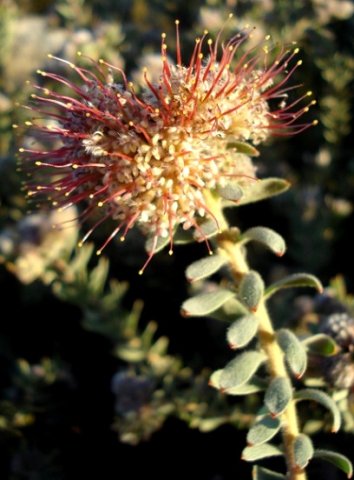Leucospermum wittebergense

Leucospermum wittebergense, the Swartberg pincushion, is a shrub that grows to about 1,5 m in height. The much branched stems are fairly erect. The stem colour is sometimes pinkish red, sometimes cream and always hairy.
In this photo of a plant growing near Oudtshoorn, the clustered flowerheads crowding the stem top are past their prime. The perianth segments below are still creamy white, becoming misshapen as they wither. Some of the hairiness that showed on the segment exterior surfaces is notable again from mutilation of the withering segment tips. Elsewhere the hairless upside down, U-shaped curves of the inside surfaces of some segments are still showing.
The pollen presenters have now mostly performed both their functions: firstly the pollen transfer task they were named for, while the stigma was still immature. The second duty of the stigma itself receiving pollen from another flower, is done when the style is withering. This ensures seed production in its own ovary below.
This pincushion is botanically named for a white mountain, while its common name relates the plant to the Swartberge (black mountains). This is not merely one of those almost inexplicable, widely favoured and uninformative South African expressions like ja-nee (yes-no)!
The plant’s distribution does include both the Swartberge, the Witteberg and also the Kouga Mountains, ranging from the east of the Western Cape to the west of the Eastern Cape. Some of these plants have even been found on the Outeniqua Mountains in the south.
The habitat is rocky slopes of fairly dry Protea fynbos areas subject to temperature extremes. The species is not considered threatened in habitat early in the twenty first century (Vlok and Schutte-Vlok, 2015; Bond and Goldblatt, 1984; iNaturalist; www.proteaatlas.org.za; http://redlist.sanbi.org).

